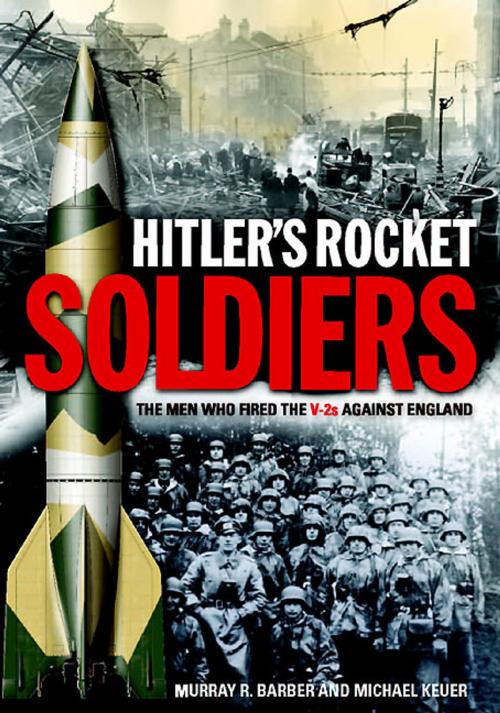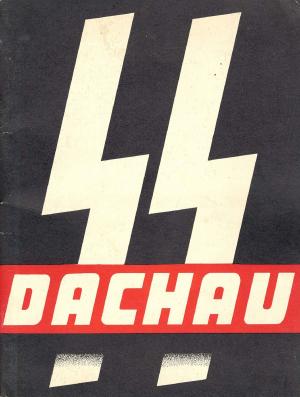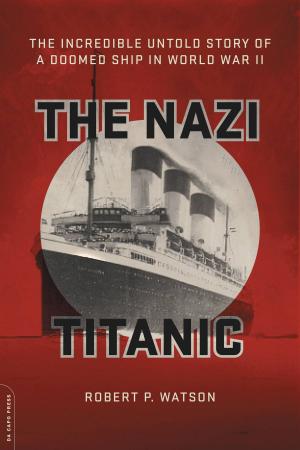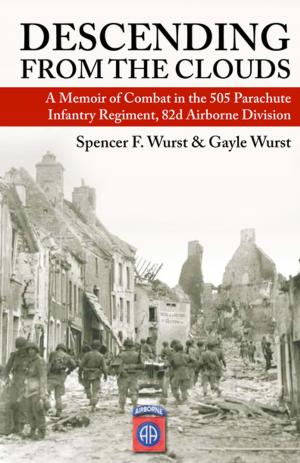Hitler's Rocket Soldiers: Firing the V-2s Against England
Firing the V-2s Against England
Nonfiction, History, Military, World War II| Author: | Barber, Murray; Keuer, Michael | ISBN: | 9780955597787 |
| Publisher: | Tattered Flag | Publication: | October 19, 2011 |
| Imprint: | Tattered Flag | Language: | English |
| Author: | Barber, Murray; Keuer, Michael |
| ISBN: | 9780955597787 |
| Publisher: | Tattered Flag |
| Publication: | October 19, 2011 |
| Imprint: | Tattered Flag |
| Language: | English |
In the final, desperate months of World War Two, at a time when the German war machine was considered by the Allies to be an almost spent force, Adolf Hitler unleashed a new weapon against England and western Europe that fell from the silence of the Earths upper atmosphere and the edge of space. It was a weapon that struck fear into the hearts and minds of wartime civilians; it came without warning and defense was impossible. This was an unseen threat that fell at supersonic speeds, leveling suburban streets to dust in seconds, terrorizing the residents of London and Antwerp this was the V2 Rocket. The V2 Vergeltungswaffen Zwei (Vengeance Weapon 2), designed by the rocket scientist and engineer, Wernher von Braun, and his colleagues at the secret Nazi research center at Peenemünde, was the most sophisticated weapon developed in Europe during the war. Following the end of hostilities, von Braun and many in his team transferred their allegiance to the United States and subsequently went on to design the mighty Saturn V that took the Americans to the moon. The experiences of von Brauns rocket team are well documented, but somewhat surprisingly, some aspects of the V2 story remain largely uncovered. This is especially true from the German perspective and more specifically, the view of the men who formed the firing teams for this formidable weapon that embraced supersonic technology. From September 1944 to early 1945, V2 launch teams fired more than 3,000 rockets, each with a high-explosive one-ton warhead, at targets in England, France, Belgium, Holland and even within Germany itself. Many rockets were fired from mobile launch sites in The Hague and from concealed wooded areas hidden from Allied aircraft, using fleets of modern, purpose-built transporters and trailers with sophisticated ancillary and support vehicles. For the first time, this book tells the story of the V2 through the eyes and experiences of the men who not only fired the missiles at targets such as London, Norwich, Antwerp and Paris, but also of some of the military scientists and technicians involved in its development. The authors have spent many years tracking down and interviewing the few surviving veterans of these little-known and secretive units and have unearthed new and rare information from firsthand accounts. These are the unique recollections of the Rocket Soldiers who have spoken candidly to the authors about their wartime duties. The accounts show that, mostly, they were not stereotypical and idealogically indoctrinated Aryan warriors, but very ordinary soldiers and technicians living through extraordinary times, handling the most sophisticated weapon ever developed in pre-nuclear Europe. The book also describes the development of German rocketry following the end of the First World War and the technology embodied within the V2. The veterans tell of their first encounters with the awesome new rocket and how, having survived the devastating RAF raid on Peenemünde, training was dispersed to test sites in Poland. They recall the move to forward firing positions, gun battles with the Resistance and the start of the rocket offensive. In truth, the more battle-experienced veterans knew that the V2 was a waste of valuable human and matériel resources a last-ditch hope to save a desperated regime. Conversely, the book illustrates how inexperienced troops drafted directly to the V2 units from basic training, vainly hoped and believed that the fortunes of war would turn in Germanys favor. The veterans tell of their desperate experiences when the inevitable defeat came, as they were rushed to the east to defend Berlin where so many Rocket Soldiers lost their lives. Yet while some V2 troops ended the war with tears of regret for a robbed youth, others shed tears of frustration, knowing that they would never live through such extraordinary times again. Hitlers Rocket Soldiers forms an important new contribution to our understanding of the German war machine and its technology. Using never-before tapped resources, this book will be a revelation and valuable resource to all military historians and those with an interest in rocket development. Murray R. Barber F.R.A.S., was born in 1956 and is married with two children. He lives in Devon, England where he pursues several business interests that are related to astronomy. He has developed and written curriculum support information for the teaching of astronomy and also on the history of ancient Egypt that is in use in planetariums worldwide. Since his schooldays he has always been interested in the history of World War Two and in particular its aviation. The V-2 rocket represents a crossover of his two main interests the wartime V-2 being the very first man-made object to enter space and which was to lead, ultimately, to vehicles traveling beyond Pluto. Through the International V-2 Research Group he met Michael Keuer and, following visits to see the remains of the Peenemünde research and development establishment on the Baltic coast, they decided to research, together, the history of the V-2 rocket. It was to fill the void of firsthand accounts of the operational use of the weapon, that the idea for this book was born. Murray R. Barber is a fellow of the Royal Astronomical Society.Michael Keuer was born in 1959 in Hannover, Germany and is a senior software developer in a veterinarian pharmaceutical supply company. He has always had a keen interest in historical technical developments and the personalities behind scientific advancement. Following the reunification of Germany, he was able to visit the previously restricted area of Peenemünde to see the remains of the development works from where the V-2 rocket was created and launched. During World War Two his grandfather worked as a technical skilled worker at Peenemünde and indeed Michaels father was born just 32 kilometers away from the cradle of modern space science. As his interest grew, he met Murray Barber and the two decided to research the reminiscences of the last few remaining men involved in the military development and employment of this extraordinary weapon of war.
In the final, desperate months of World War Two, at a time when the German war machine was considered by the Allies to be an almost spent force, Adolf Hitler unleashed a new weapon against England and western Europe that fell from the silence of the Earths upper atmosphere and the edge of space. It was a weapon that struck fear into the hearts and minds of wartime civilians; it came without warning and defense was impossible. This was an unseen threat that fell at supersonic speeds, leveling suburban streets to dust in seconds, terrorizing the residents of London and Antwerp this was the V2 Rocket. The V2 Vergeltungswaffen Zwei (Vengeance Weapon 2), designed by the rocket scientist and engineer, Wernher von Braun, and his colleagues at the secret Nazi research center at Peenemünde, was the most sophisticated weapon developed in Europe during the war. Following the end of hostilities, von Braun and many in his team transferred their allegiance to the United States and subsequently went on to design the mighty Saturn V that took the Americans to the moon. The experiences of von Brauns rocket team are well documented, but somewhat surprisingly, some aspects of the V2 story remain largely uncovered. This is especially true from the German perspective and more specifically, the view of the men who formed the firing teams for this formidable weapon that embraced supersonic technology. From September 1944 to early 1945, V2 launch teams fired more than 3,000 rockets, each with a high-explosive one-ton warhead, at targets in England, France, Belgium, Holland and even within Germany itself. Many rockets were fired from mobile launch sites in The Hague and from concealed wooded areas hidden from Allied aircraft, using fleets of modern, purpose-built transporters and trailers with sophisticated ancillary and support vehicles. For the first time, this book tells the story of the V2 through the eyes and experiences of the men who not only fired the missiles at targets such as London, Norwich, Antwerp and Paris, but also of some of the military scientists and technicians involved in its development. The authors have spent many years tracking down and interviewing the few surviving veterans of these little-known and secretive units and have unearthed new and rare information from firsthand accounts. These are the unique recollections of the Rocket Soldiers who have spoken candidly to the authors about their wartime duties. The accounts show that, mostly, they were not stereotypical and idealogically indoctrinated Aryan warriors, but very ordinary soldiers and technicians living through extraordinary times, handling the most sophisticated weapon ever developed in pre-nuclear Europe. The book also describes the development of German rocketry following the end of the First World War and the technology embodied within the V2. The veterans tell of their first encounters with the awesome new rocket and how, having survived the devastating RAF raid on Peenemünde, training was dispersed to test sites in Poland. They recall the move to forward firing positions, gun battles with the Resistance and the start of the rocket offensive. In truth, the more battle-experienced veterans knew that the V2 was a waste of valuable human and matériel resources a last-ditch hope to save a desperated regime. Conversely, the book illustrates how inexperienced troops drafted directly to the V2 units from basic training, vainly hoped and believed that the fortunes of war would turn in Germanys favor. The veterans tell of their desperate experiences when the inevitable defeat came, as they were rushed to the east to defend Berlin where so many Rocket Soldiers lost their lives. Yet while some V2 troops ended the war with tears of regret for a robbed youth, others shed tears of frustration, knowing that they would never live through such extraordinary times again. Hitlers Rocket Soldiers forms an important new contribution to our understanding of the German war machine and its technology. Using never-before tapped resources, this book will be a revelation and valuable resource to all military historians and those with an interest in rocket development. Murray R. Barber F.R.A.S., was born in 1956 and is married with two children. He lives in Devon, England where he pursues several business interests that are related to astronomy. He has developed and written curriculum support information for the teaching of astronomy and also on the history of ancient Egypt that is in use in planetariums worldwide. Since his schooldays he has always been interested in the history of World War Two and in particular its aviation. The V-2 rocket represents a crossover of his two main interests the wartime V-2 being the very first man-made object to enter space and which was to lead, ultimately, to vehicles traveling beyond Pluto. Through the International V-2 Research Group he met Michael Keuer and, following visits to see the remains of the Peenemünde research and development establishment on the Baltic coast, they decided to research, together, the history of the V-2 rocket. It was to fill the void of firsthand accounts of the operational use of the weapon, that the idea for this book was born. Murray R. Barber is a fellow of the Royal Astronomical Society.Michael Keuer was born in 1959 in Hannover, Germany and is a senior software developer in a veterinarian pharmaceutical supply company. He has always had a keen interest in historical technical developments and the personalities behind scientific advancement. Following the reunification of Germany, he was able to visit the previously restricted area of Peenemünde to see the remains of the development works from where the V-2 rocket was created and launched. During World War Two his grandfather worked as a technical skilled worker at Peenemünde and indeed Michaels father was born just 32 kilometers away from the cradle of modern space science. As his interest grew, he met Murray Barber and the two decided to research the reminiscences of the last few remaining men involved in the military development and employment of this extraordinary weapon of war.















